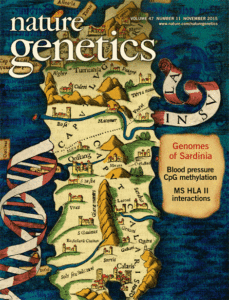
A team of international researchers from the SardiNIA/ProgeNIA study, have discovered new genes associated with height, risk factors for heart disease, and regulation of hemoglobin levels, using advanced whole-genome sequencing technology. Findings detected in general population individuals from 4 Sardinian villages assessed in the SardiNIA cohort study are presented in a series of papers in the November 11, 2015 issue of Nature Genetics.
Begun in 2001, the SardiNIA study originally focused on common genetic variants to determine whether they correlated with particular traits, such as a predisposition to high or low cholesterol, for example. This research provided a general map for where and how a trait might be regulated, but did not account for rarer or more population-specific genetic variants that might have a strong influence on a particular trait.
The development of genome-wide sequencing technology has enabled SardiNIA researchers to expand their assessment to rare and population specific variants. By sequencing the whole genome of 2,210 Sardinians and by reconstructing, with statistical models, the genome of the other volunteers, they assessed up to 17 million DNA variants in 6,600 individuals and associated them with trait variation.
Findings from this complete-variant analysis are reported in the Nature Genetics papers:
- Two new gene variants were found to have a significant effect on stature in Sardinians. Together, they appear to reduce height by 6 centimeters. Researchers found additional height-decreasing alleles consistently across the Sardinian population that reflect an observed “island effect” in which large, island-dwelling mammals decrease in size over time.
- Researchers identified 14 novel genetic variants associated with serum lipid levels, and 19 associated with inflammatory markers in the blood. Both lipid levels and inflammatory markers may influence risk of heart disease.
- For the first time, researchers concurrently analyzed gene regulation of levels of the three different forms of hemoglobin present in adults, to see if there was any coordination in their regulation. Twenty-three associations were seen at 10 loci, including five new gene candidates. Half the variants showed associations with more than one type of hemoglobin.
SardiNIA/ProgeNIA is an international research collaboration led by Francesco Cucca director of the Institute of Genetic and Biomedical Research of the Italian Research Council (IRGB-CNR), with David Schlessinger, NIH Distinguished Investigator of the National Institute on Aging at NIH, and Goncalo Abecasis Chair, Department of Biostatistics, University of Michigan, Ann Arbor co-PIs of the study. The goal of the study is to identify genes associated with disease risk and other traits common among people living on the Mediterranean island of Sardinia.
Sardinia is an ideal location for genetic analysis because it has had very little population in-migration for long periods, so its people and especially those assessed in the SardiNIA study are genetically more inter-related than others. At the same time is also a diverse population and provides an excellent representation of genetic variation found in Europe as a whole. This is why many of the genes first associated with traits and disease risk in Sardinians have been found to be significant in larger, more diverse populations as well.
ARTICLES:
“Genome sequencing elucidates Sardinian genetic architecture and augments association analyses for lipid and blood inflammatory markers.” by Carlo Sidore, et al. Nat Genet. 2015 Nov;47(11):1272-1281. doi: 10.1038/ng.3368. Epub 2015 Sep 14.
“Genome-wide association analyses based on whole-genome sequencing in Sardinia provide insights into regulation of hemoglobin levels” by Fabrice Danjou, et al. Nat Genet. 2015 Nat Genet. 2015 Nov;47(11):1264-71. doi: 10.1038/ng.3307. Epub 2015 Sep 14.
“Height reducing variants and selection for short stature on the island of Sardinia” by Magdalena Zoledziewska et al. Nature Genetics. Nat Genet. 2015 Nov;47(11):1352-1356. doi: 10.1038/ng.3403. Epub 2015 Sep 14.

